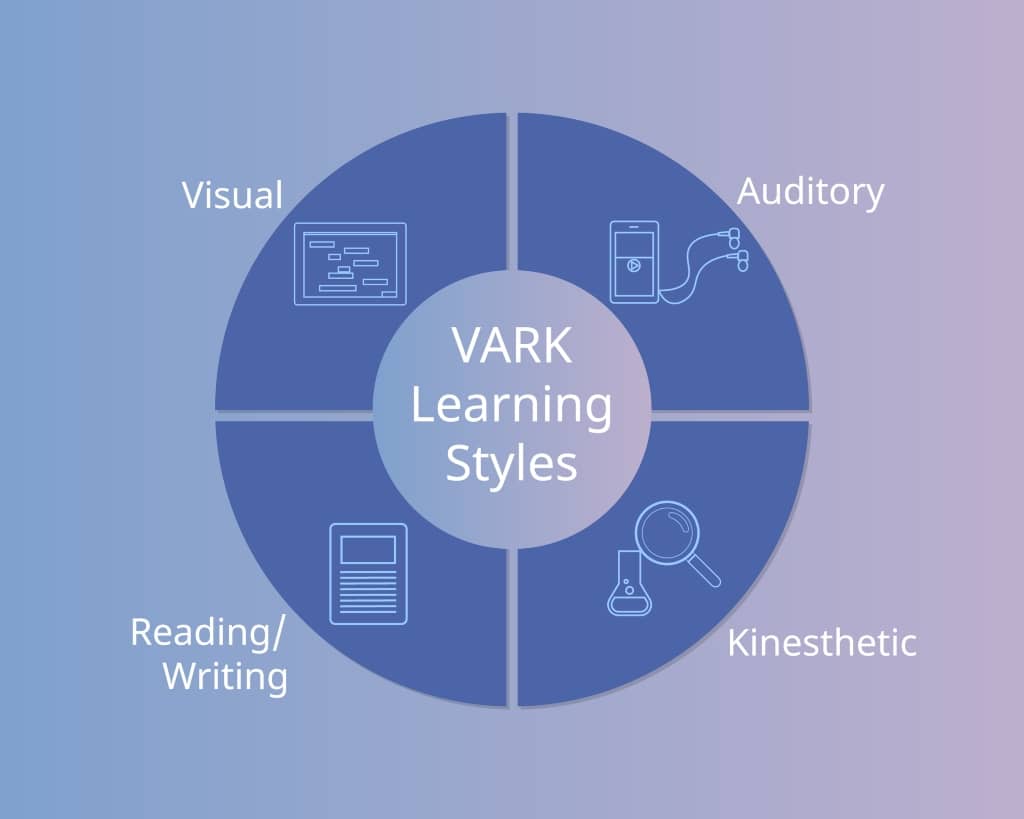8 Types of Learning Styles Educators Need To Know About
As people vary in behavior or appearance, so do the learning styles that suit them differ.
It's not uncommon to worry if your learners are getting the best out of your teaching style.
Adapting that and your teaching material to fit their various learning styles is one way to ensure that they get the best value out of their education.

As a teacher, you most likely know that the different learning styles under VARK have persisted to date.
But is there more to it?
Are there other learning styles that could benefit your students?
From high school to higher education, new information has come to light about student learning styles and how they learn in a different way beyond the well-known VARK model.
This piece will discuss learning techniques — including VARK — and how you can apply each one to complement your student's learning styles, strengths, and learner engagement.
What is VARK?
In 1992, Fleming and Mills suggested four modalities that would extensively customize the learning experience for learners.
Their learning styles theory suggested that students fell into one of the following learning styles; Visual, Aural, Read/Write, and Kinesthetic, (thus the abbreviation, VARK).
And educators needed to modify their teaching methods according to a preferred style.
A visual learning style describes a learner who prefers to learn through a diagram. Aural (also called auditory) deals with those who learn better with sound, while Read/Write learners absorb information quickly when they read it and retain more when they write it out.
And a Kinesthetic learner learns by doing.
Like every other concept concerning humans, there is some overlap among these different learning styles, and instructors will benefit by embracing a blended learning style.
But most importantly, VARK isn't a shortcut to increasing student performance, as multiple learning styles can favor each learner in a different way.
Instead, see it as a guide to making the teaching process more accessible.
VARK Learning Styles
Let's walk through the various VARK learning styles in depth:

Visual (spatial) Learners
Visual learners prefer to learn via diagrams. Their heightened spatial awareness allows them to rapidly absorb and understand what they can see.
Whiteboards, maps, flowcharts, and any other type of visually designed material get them in the groove. They might, however, struggle with videos and images.
They use the occipital lobes in their brains when learning. These lobes manage spatial orientation. You'll often find these types of learners doodling or drawing.
Auditory (aural) Learners
Unlike visual learners, the temporal lobe is the primary learning part of their brain. An auditory learner is a great listener and learns best through verbal monologues such as lectures, music, speeches, and even podcasts — they soak up the information immediately.
They are often the first to ask questions during a meeting, as they can quickly process what's been said. Auditory learners make up about 30% of the world's population.
Read & Write (spacial) Learners
These learners are wordsmiths. They love using words (in speech and writing) when learning.
They find reading and writing fun and love activities that allow them to put their reading and writing skills to play.
Debates, journalism, speech writing, and speaking are examples of learning activities these learners love.
They are avid note-takers and readers who quickly grasp and simplify a complex concept with a well-written essay.
Their strong writing skills also open opportunities by working for top essay writing services, where they can assist others in crafting high-quality academic content.
Kinesthetic (physical) Learners
Kinesthetic learners (aka physical learners) are tactile learners. They learn by doing.

A lengthy presentation? Yawn. All these energy bunnies want to do is get their hands dirty.
Figuring out how things work is their way of absorbing and understanding any concepts you need them to grasp.
Beyond VARK: Additional Learning Styles
However, VARK has its blind spots.

Fleming never meant it to serve as a rigid classification for learners anyway. Here are additional learning styles that are also valid learning modes for students:
Verbal (linguistic) Learners
Verbal and linguistic learners process information through words.
However, they differ from Read/Write learners as they process information while discussing it. If you find one of your students often repeating verbal instructions given back to you, you may have a verbal learner on your hands.
A linguistic learner often organizes information in their heads as they speak and are least likely to forget information they have discussed when assured that it makes sense.
When learning, verbal learners mostly use the temporal and frontal lobes of their brain.
Logical (mathematical) Learners
This class of learners is notorious for sticking with facts and aspects of learning that require logic.
The mind of the logical learner assigns variables to pieces of information and mathematically processes them into logically sound instructions for storage.
Logical learners are more likely to challenge the information given to them to test how logically sound it is.
Students who are likely to argue with you could be logical learners. They always need to test the logical integrity of what they receive.
Logical learners rely heavily on the parietal lobes of their brain to learn.
The left side of the parietal lobe drives our rational thinking, so it only makes sense that this part is most active during learning.
Social (interpersonal) Learners
A social learner is by far one of the friendliest of learners.
These interpersonal learners are avid and adept communicators.
They are lively when learning in groups and never hesitate to engage the classroom socially when they want to know more.
Students who shine brighter during group projects or are usually more active during group discussions are social learners.
They often show up for group projects and extra-curricular activities as they need to connect with others.
Social learners rely heavily on their brains' frontal and temporal lobes when learning.
The limbic system is also responsible for controlling an individual's social and solitary styles, so naturally, it comes into play for social learners.
Solitary (intrapersonal) Learners
Solitary learners, also intrapersonal learners, prefer to stay alone when learning. And without any distractions, these learners are at their best.
They retain the data best by figuring out and making connections with the course materials and information on their own.
Solitary learners may not perform well in class but do better outside of it.
One of the best learning strategies for dealing with them is to supply them with whatever they may need and leave them to figure it out independently without any pressure, and they would be sure to deliver.
Just be sure to check in on them occasionally.
For a solitary learner, the frontal and parietal lobes of the brain influence their learning preference.
Do Learners Have More Than One Learning Style?
Yes! Having more than one individual learning style is the standard.
Most learners tune to two, three, or more different learning styles in varying degrees.
A visual learner could also be a solitary learner as they peruse the texts and visual materials alone. They could also adopt a verbal learning style by discussing their findings with their peers.
Using a different style of learning significantly improves ones learning and retention capacity.
While most students (when asked) often have a preferred learning style, developing their other learning styles makes them more rounded individuals and keeps them adaptable to different sources of information.
You can ask a set of questions known as "the VARK questionnaire" to discover the preferred learning styles of any student. But your findings shouldn't create any biases.
Instead, it should help you improve the quality of your teaching methods and the course material. Finally, be cautious not to exaggerate the relevance of these results to the learning process.
The amount of information that finds us — thanks to the internet — demands that we develop multiple learning styles to function effectively in society.
Final Thoughts
Multiple learning styles do not make your work as a tutor more difficult.

In fact, one could argue that understanding them makes your job much easier.
No matter the kinds of learning techniques you discover in your class, be sure to adopt different teaching styles and deliver the course material in multiple formats — as all these will help the students absorb the material better.
When developing your training materials, considering the different learning styles is a great way to improve the learning experience.
Dozie Anyaegbunam is a B2B content writer and strategist. A Cannes Lions certified storyteller, Dozie has crafted compelling content for brands such as Mirasee, SmartBlogger, Growth Mentor, and more. He's also Dodo and Ronan's dad, a proud flâneur, and a Felix Baumgartner wannabe. Don't miss his podcast, The Newcomers, where he interviews immigrants about the struggles and lessons that come with starting life in a new country.